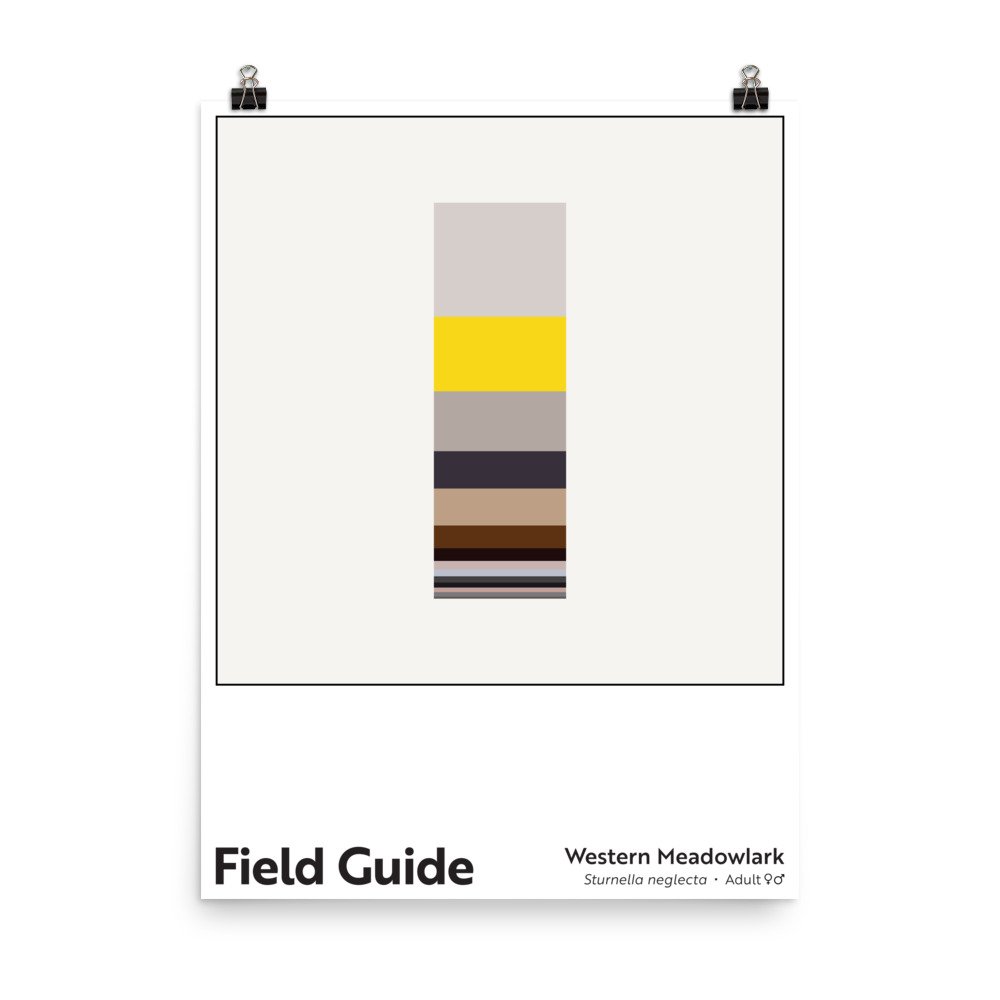Field Guide : Western Meadowlark
Unlimited edition. 18 x 24 inch, museum-quality poster on matte paper.
The western meadowlark is one of North America’s most abundant and widely distributed pasture and grassland birds. Because they are ground foragers, it’s easy to overlook these birds in tall grasses. Easy, that is, until the male hops onto a fence post, boulder, or some other raised stage and lets loose his liquid warble. In his Birds Of California (1923), the ornithologist William Dawson wrote, “It is impossible not to rhapsodize over the meadowlark. He is a rhapsodist himself. Born of the soil and lost in its embraces for such time as it pleases him, he yet quits his lowly station ever and again, mounts some fence-post or tree-top, and publishes to the world an unquenchable gladness in things-as-they-are.”
The territorial song of the male is often described as “watery” or “flute-like”; for this child of the 1970s, though, it calls to mind a happy droid. That long-time-ago-in-a-galaxy-far-far-away sonic association is quite distinct, however, from my ever-strengthening sense memory connection to the song. For me, it calls to mind spring or summer mornings here in Northern California’s oak savannah and grasslands, where the warble and chup of the meadowlarks begins even before the sun has risen.
The western meadowlark’s scientific binomial is a curious one. Sturnella neglecta translates as “starling-like neglected bird.” Why “neglected”? And is the meadowlark actually a type of starling? In fact, no, the western meadowlark is a New World blackbird species, a member of the Icteridae family, related to orioles, grackles, cowbirds, and the bobolink, but taxonomists noted that meadowlarks were shaped and sized like starlings, even if they were very differently dressed, and decided to dub the genus Sturnella, or “starling like.” The species name was given by John James Audubon because the western meadowlark had not been formally described by Lewis and Clark during their 1803-1806 expedition, and Audubon said the bird had therefore been “ignored” or “neglected.” And what about the common name? “Western” and “meadow” are good habitat descriptors, and “lark” makes sense because the species is such a wonderful singer (larks are known for their voices), but meadowlarks aren’t actually a species of lark. Whatever we humans call them, they’ll keep rhapsodizing.
Note: These archival poster prints feature rich, appealing colors. I encourage customers to take care in handling them until they are framed/protected for display; the darker colors on the matte paper can be scratched. They ship rolled, so customers need to flatten them before framing (or have their framer do so).
Charitable Sales Model: Whenever one of these poster prints is purchased, a charitable contribution equal to 10% of the print’s cost (or $3.60) is made to a nonprofit working to tackle environmental or social challenges. Read more about my charitable sales model here.
Unlimited edition. 18 x 24 inch, museum-quality poster on matte paper.
The western meadowlark is one of North America’s most abundant and widely distributed pasture and grassland birds. Because they are ground foragers, it’s easy to overlook these birds in tall grasses. Easy, that is, until the male hops onto a fence post, boulder, or some other raised stage and lets loose his liquid warble. In his Birds Of California (1923), the ornithologist William Dawson wrote, “It is impossible not to rhapsodize over the meadowlark. He is a rhapsodist himself. Born of the soil and lost in its embraces for such time as it pleases him, he yet quits his lowly station ever and again, mounts some fence-post or tree-top, and publishes to the world an unquenchable gladness in things-as-they-are.”
The territorial song of the male is often described as “watery” or “flute-like”; for this child of the 1970s, though, it calls to mind a happy droid. That long-time-ago-in-a-galaxy-far-far-away sonic association is quite distinct, however, from my ever-strengthening sense memory connection to the song. For me, it calls to mind spring or summer mornings here in Northern California’s oak savannah and grasslands, where the warble and chup of the meadowlarks begins even before the sun has risen.
The western meadowlark’s scientific binomial is a curious one. Sturnella neglecta translates as “starling-like neglected bird.” Why “neglected”? And is the meadowlark actually a type of starling? In fact, no, the western meadowlark is a New World blackbird species, a member of the Icteridae family, related to orioles, grackles, cowbirds, and the bobolink, but taxonomists noted that meadowlarks were shaped and sized like starlings, even if they were very differently dressed, and decided to dub the genus Sturnella, or “starling like.” The species name was given by John James Audubon because the western meadowlark had not been formally described by Lewis and Clark during their 1803-1806 expedition, and Audubon said the bird had therefore been “ignored” or “neglected.” And what about the common name? “Western” and “meadow” are good habitat descriptors, and “lark” makes sense because the species is such a wonderful singer (larks are known for their voices), but meadowlarks aren’t actually a species of lark. Whatever we humans call them, they’ll keep rhapsodizing.
Note: These archival poster prints feature rich, appealing colors. I encourage customers to take care in handling them until they are framed/protected for display; the darker colors on the matte paper can be scratched. They ship rolled, so customers need to flatten them before framing (or have their framer do so).
Charitable Sales Model: Whenever one of these poster prints is purchased, a charitable contribution equal to 10% of the print’s cost (or $3.60) is made to a nonprofit working to tackle environmental or social challenges. Read more about my charitable sales model here.
Unlimited edition. 18 x 24 inch, museum-quality poster on matte paper.
The western meadowlark is one of North America’s most abundant and widely distributed pasture and grassland birds. Because they are ground foragers, it’s easy to overlook these birds in tall grasses. Easy, that is, until the male hops onto a fence post, boulder, or some other raised stage and lets loose his liquid warble. In his Birds Of California (1923), the ornithologist William Dawson wrote, “It is impossible not to rhapsodize over the meadowlark. He is a rhapsodist himself. Born of the soil and lost in its embraces for such time as it pleases him, he yet quits his lowly station ever and again, mounts some fence-post or tree-top, and publishes to the world an unquenchable gladness in things-as-they-are.”
The territorial song of the male is often described as “watery” or “flute-like”; for this child of the 1970s, though, it calls to mind a happy droid. That long-time-ago-in-a-galaxy-far-far-away sonic association is quite distinct, however, from my ever-strengthening sense memory connection to the song. For me, it calls to mind spring or summer mornings here in Northern California’s oak savannah and grasslands, where the warble and chup of the meadowlarks begins even before the sun has risen.
The western meadowlark’s scientific binomial is a curious one. Sturnella neglecta translates as “starling-like neglected bird.” Why “neglected”? And is the meadowlark actually a type of starling? In fact, no, the western meadowlark is a New World blackbird species, a member of the Icteridae family, related to orioles, grackles, cowbirds, and the bobolink, but taxonomists noted that meadowlarks were shaped and sized like starlings, even if they were very differently dressed, and decided to dub the genus Sturnella, or “starling like.” The species name was given by John James Audubon because the western meadowlark had not been formally described by Lewis and Clark during their 1803-1806 expedition, and Audubon said the bird had therefore been “ignored” or “neglected.” And what about the common name? “Western” and “meadow” are good habitat descriptors, and “lark” makes sense because the species is such a wonderful singer (larks are known for their voices), but meadowlarks aren’t actually a species of lark. Whatever we humans call them, they’ll keep rhapsodizing.
Note: These archival poster prints feature rich, appealing colors. I encourage customers to take care in handling them until they are framed/protected for display; the darker colors on the matte paper can be scratched. They ship rolled, so customers need to flatten them before framing (or have their framer do so).
Charitable Sales Model: Whenever one of these poster prints is purchased, a charitable contribution equal to 10% of the print’s cost (or $3.60) is made to a nonprofit working to tackle environmental or social challenges. Read more about my charitable sales model here.

